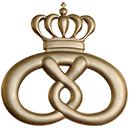
How Danish Layer Cakes Became a Favorite Dessert and Tradition
Monday, January 29, 2024
Denmark, a nation abundant in dairy resources like milk, cream, butter, and eggs, capitalized on these ingredients to cultivate a baking and cake-eating culture. Unbeknownst to them, this cultural tradition sparked a phenomenon known as hygge, encouraging people to take a break from life’s pressures and cherish moments with loved ones. It’s no wonder that numerous recipes have been handed down through generations, as many have grown up honing their baking skills in the kitchen.

Denmark boasts a range of traditional cakes. Some favorites include Kransekage, a stack of ring cakes often seen at weddings and special occasions, rugbrødkage (rye bread cake with blackberry jam), and drømmekage (Danish Dream Cake, a delightful sponge cake topped with caramel). But the real star? Lagkage – a heavenly multilayered vanilla sponge cake filled with jam and cream. Its name literally translates to ‘layer cake’ – imagine stacked layers of cake held together by frosting or other sweet fillings. If you’re off to a birthday bash in Denmark, you can bet a delicious layer cake will be waiting for you!
What are Danish Layer Cakes?
Dansk lagkage, better known as Danish Layer Cake, holds a special place in the hearts of Danes and fans worldwide, particularly in Racine, Wisconsin. What defines an authentic Danish Layer Cake? It’s the use of farm-fresh eggs, whole cream milk, butter, rich heavy cream, and seedless raspberry jam, showcasing the essence of Danish decadence.
This cherished dessert is traditionally crafted with layers of velvety soft vanilla cake, each separated by raspberry jam and pastry cream. Finally, it’s crowned with a generous covering of vanilla buttercream frosting. The traditional Danish Layer Cake baking technique involves baking individual layers from separate batters before stacking and filling each. In contrast, contemporary methods use a single batter in multiple pans or one large cake sliced into layers. This approach is an easier and faster way of creating layer cakes, but it is not Danish.
Early History of Danish Layer Cakes
The roots of Layer Cakes stretch back to the late 1800s in Europe. In Medieval times, these cakes symbolized wealth and status, with only the affluent able to afford the scarce ingredients. Bakers were entrusted with crafting exquisite cake masterpieces, serving as the focal point for extravagant banquets and celebrations.
The Industrial Revolution brought about the introduction of cast iron stoves to American households, replacing the less dependable brick hearths. This innovation facilitated a more straightforward baking process, giving rise to the creation of layer cakes. Numerous inventions and advancements from this era streamlined ingredient cultivation, such as baking powder contributed to the production of fluffier cakes.
Embracing Tradition and Innovation
Originally centered around a delightful dough-and-cream combination, these cakes have evolved, now featuring enhancements such as fruit preserves, nuts, and marzipan. Modern variations also expand beyond the classic Scandinavian strawberry filling, incorporating flavors like chocolate and coffee.
Another is the Othellokage. Yes – it’s named after Shakespeare’s play, with the dark chocolate and cream representing Othello and Desdemona’s relationship. It might also be because this cake is dramatically decadent, containing alternating layers of cake and cream, marzipan, macaroon, chocolate icing, and topped with buttercream roses.
While newer recipes bring innovation, many hold the traditional three-layer cake recipes in high regard for their richness and authenticity. In Denmark, cakes symbolize more than special occasions like birthdays or Christmas – they embody a way of life enjoyed year-round.
Importance of Danish Layer Cakes to Danish Culture
![[...] [...]](/images/blog/blog0000169-hygge-with-cake.jpg)
“In Denmark, cake is more than just a delicious treat; it symbolizes ‘coziness and joy.’ This Danish concept, known as hygge, embodies a sense of well-being, contentment, and conviviality. Cake is the ultimate comfort food, and typically shared amongst friends and family. Layer Cakes are popular for birthdays, holiday gatherings and for those “just because” moments.
Sharing cake with others is a daily affair that has made it into the corporate culture with shared breakfast and teatime treats, including fredagskage, or “Friday Cake.”
The lagkage is so integral to Danish culture that it’s inspired several popular idioms. “Ikke lutter lagkage” means “not just layer cake,” reminding us that not everything is fun and games, like eating layer cake.
O&H Variations of Danish Layer Cakes

At Wisconsin’s authentic O&H Danish Bakery, we hand make and decorate various Dansk lagkager. Our range includes Traditional Danish Layer Cake, Fudge, Chocolate Cake, and our seasonal Raspberry Lemonade Mousse Cake. We also make a Gluten-Free Trinity Layer Cake for those with special dietary needs.
Danish Layer Cakes Delivered to Your Doorstep
After all that talk about cake has us craving a slice, if you do not have the time to make a Danish Layer Cake have no fear! You can order a layer cake from O&H Danish Bakery and have it delivered to your doorstep. Browse our tempting dessert collection and satisfy your cravings!
With numerous types of Danish Layer Cakes available, the popularity of this phenomenon shows no sign of abating. Danish Layer Cakes are an inextricable part of Danish history and culture, and they have also found their place as a daily and special celebration staple in the United States. So browse O&H’s incomparable dessert collection and order today, or contact us with any questions.




